NTDS, the Naval Tactical Data System, revolutionized fleet air defense when it arrived on the scene in the early 60s. Now, ships could automatically share their tactical pictures, updated by computers, which allowed the fleet to keep up with the speed of jet aircraft. However, NTDS was limited to the larger ships, carriers and cruisers, by its cost and size, and cheaper systems would be needed for smaller ships or cash-strapped navies. Several nations developed their own systems, but the US Navy was never able to modernize the existing fleet, as systems foundered due to the cost of the war in Vietnam and the postwar budget crash.
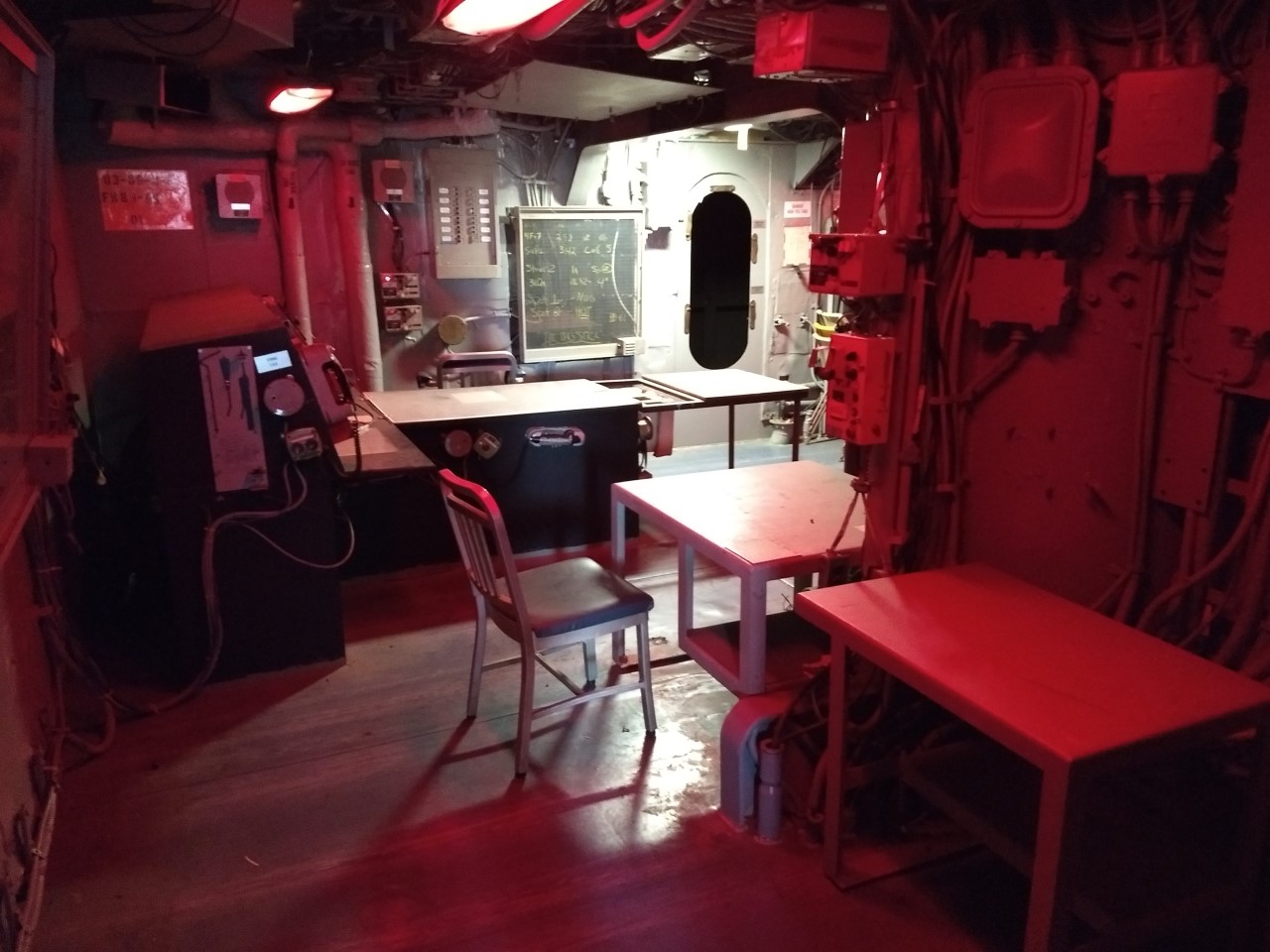
Iowa's Flag Plot, which would hook into NTDS
By the early 70s, NTDS itself was in trouble. Its software was modular, which made it easy to add new capabilities as they became necessary, even at the behest of the ship's own crew. However, the result was a system ever more overloaded, particularly as the NTDS architecture focused on one task at a time, giving the illusion of multi-tasking by flipping through modules. As more software was written, the interval between repeats rose, and the system soon became unusable. The system could only accept operator inputs in certain timeslots, which meant that the time to move the cursor across the screen rose from 3 seconds to 16 seconds, and in a few cases response lag to button pushes rose to over a minute. This meant that NTDS had serious problems tracking targets, with 15 to 25% of tracks during testing being 5 or more miles from their actual location, and a lag of 3.2 minutes from a new one showing up on radar to being entered into the system.
Things were only going to get worse in the late 70s, as the Navy moved into more complicated littoral environments like the Persian Gulf and new systems that would benefit greatly from NTDS integration entered service. Some were shipboard, like radars capable of automatically detecting targets from radar video, electronic detection systems like SLQ-32 and Outboard, and even the ship's sonars. Others were datalinks from other platforms, like the E-2 Hawkeye AWACS and the new LAMPS anti-submarine helicopter. New weapons like Tomahawk and Harpoon also required greater computational resources.
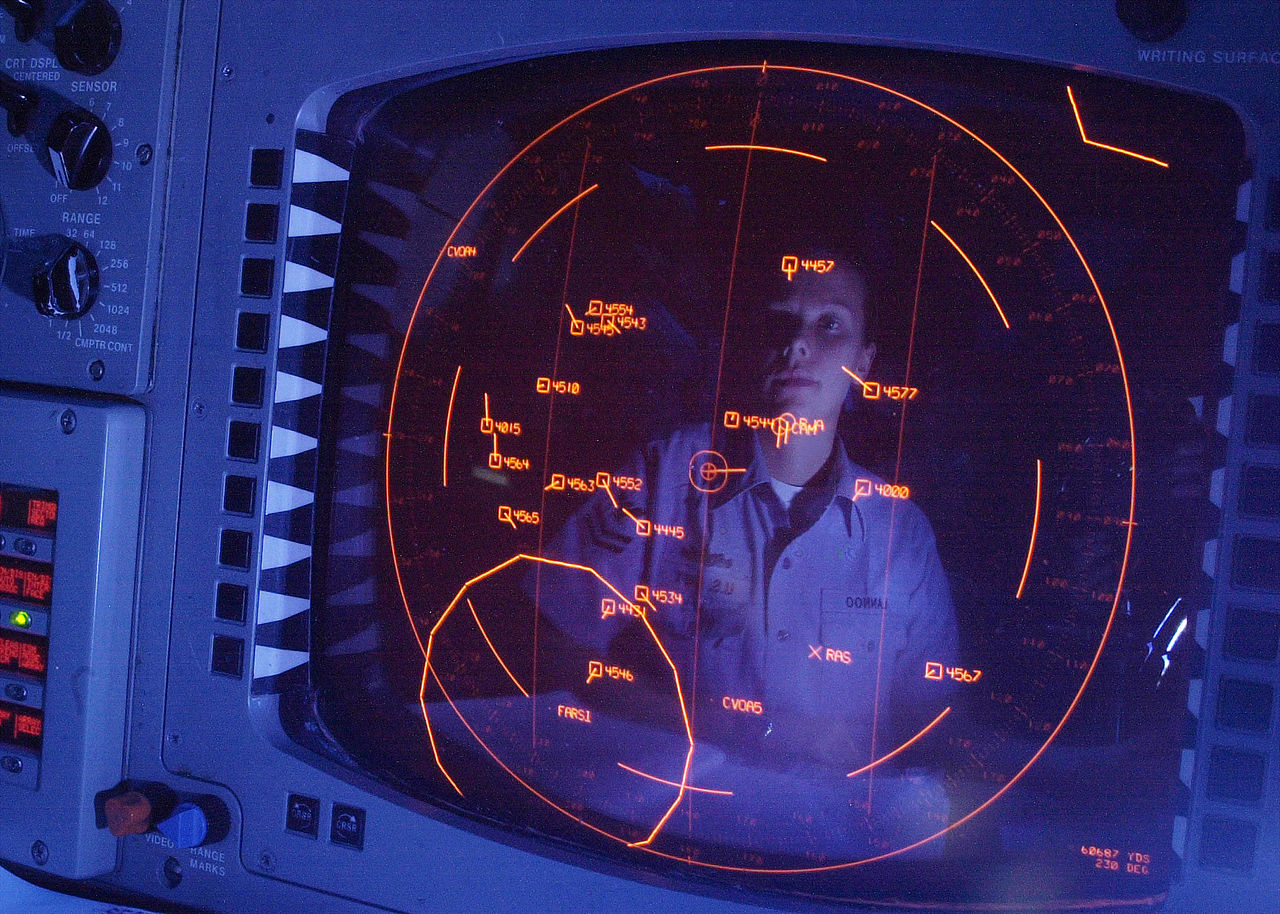
An NTDS Console
There were a few ways to go about solving this problem. One was to simply make use of Moore's Law, which was rapidly improving computer performance. The USQ-20s of the original NTDS had been replaced by the 32-bit UKY-7 in the early 70s, but it hadn't been enough. The UKY-43 offered even more performance, but to take full advantage of it, the software would need to be rewritten. When NTDS was originally developed, computers were large and expensive, and so a ship would have only one or two. Now, it was easy to delegate many functions, from running the datalink to handling electronic warfare, to specialized computers that would pass their information back to the central NTDS computer. Weapon control was likewise moved back out of NTDS and into a dedicated system.
Link 11 was also a serious bottleneck for improvements in NTDS and other combat/networking systems. Bandwidth was low, resistance to jamming was even lower, and there was still the tricky problem of figuring out where everyone was relative to each other. The proposed solution was a new datalink, known as Link 16. It was designed for use with both aircraft and ships, and used line-of-sight UHF radios to increase bandwidth. The gridlock problem would be solved by using timing between the various members of the network, which would allow them to establish relative positions through triangulation. Link 16 also offered a bigger vocabulary1 and more precision than Link 11. The only drawback was that the line-of-sight radios were insufficient for a dispersed task force. To solve this, NATO developed a system that passed Link 16 messages over Link 11 radios, known as Link 22, while the USN preferred a system which used satellite radios with Link 16 messages. Both were made possible by GPS, which for the first time allowed ships to navigate with sufficient accuracy for network participation.
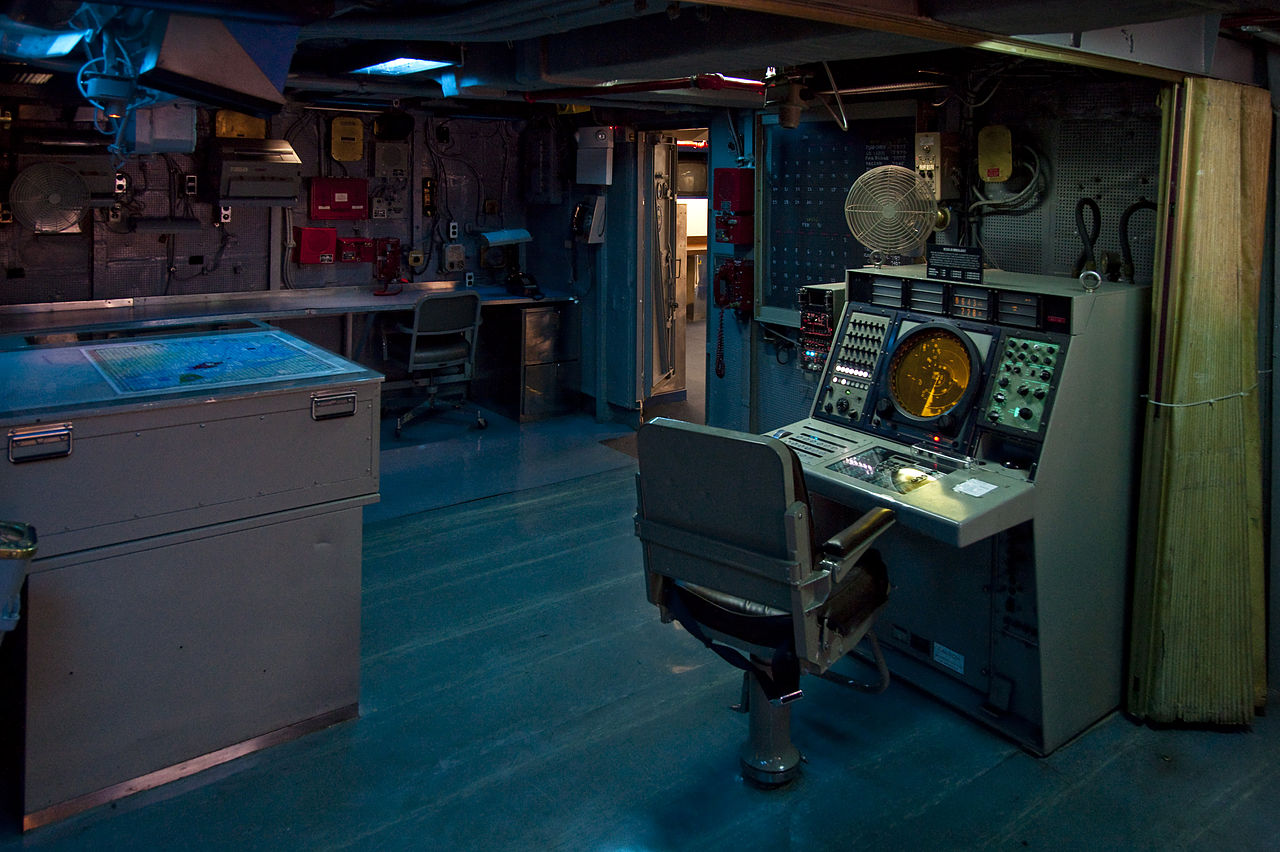
The restored CIC aboard Midway
At about the same time that all of these changes were going on with NTDS, Aegis entered the picture. Aegis was in many ways the ultimate development of the single-ship CIC concept, integrating all of the data available to an individual ship and keeping track of where everything was at a level that had previously been reserved for dedicated fire-control systems. The exact number of tracks available is obviously classified, but similar systems have been credited with being able to monitor a thousand contacts. This gives vastly greater situational awareness, and Aegis vessels have been used to monitor and control airspace when AWACS aircraft are not available. Aegis was also able to take advantage of improvements in computers to offer tactical aid to the crew, recommending weapons to engage a target. In automatic mode, it is capable of attacking anything that violates user-set rules, subject to manual veto.
Most of the information came from the SPY-1 radar, an electronically-scanned phased array capable of searching the whole volume around the ship within seconds. The precision of the whole system was leveraged to give new capabilities to the ship's weapons. Earlier SAMs had generally required the ship to paint the target with a special radar beam called an illuminator for their entire flight. This meant that the number of targets a ship could engage was limited by illuminator availability, and electronic interference meant that a ship rarely carried more than four. Aegis offered a new alternative. The missile was fitted with an autopilot that could be updated by radio link from the ship, and Aegis would simply order it to fly to where the target would be. This wasn't precise enough to actually hit the target, but it meant that the illuminators didn't have to switch on until the last few seconds of the flight, greatly increasing the number of missiles that could be in the air simultaneously.
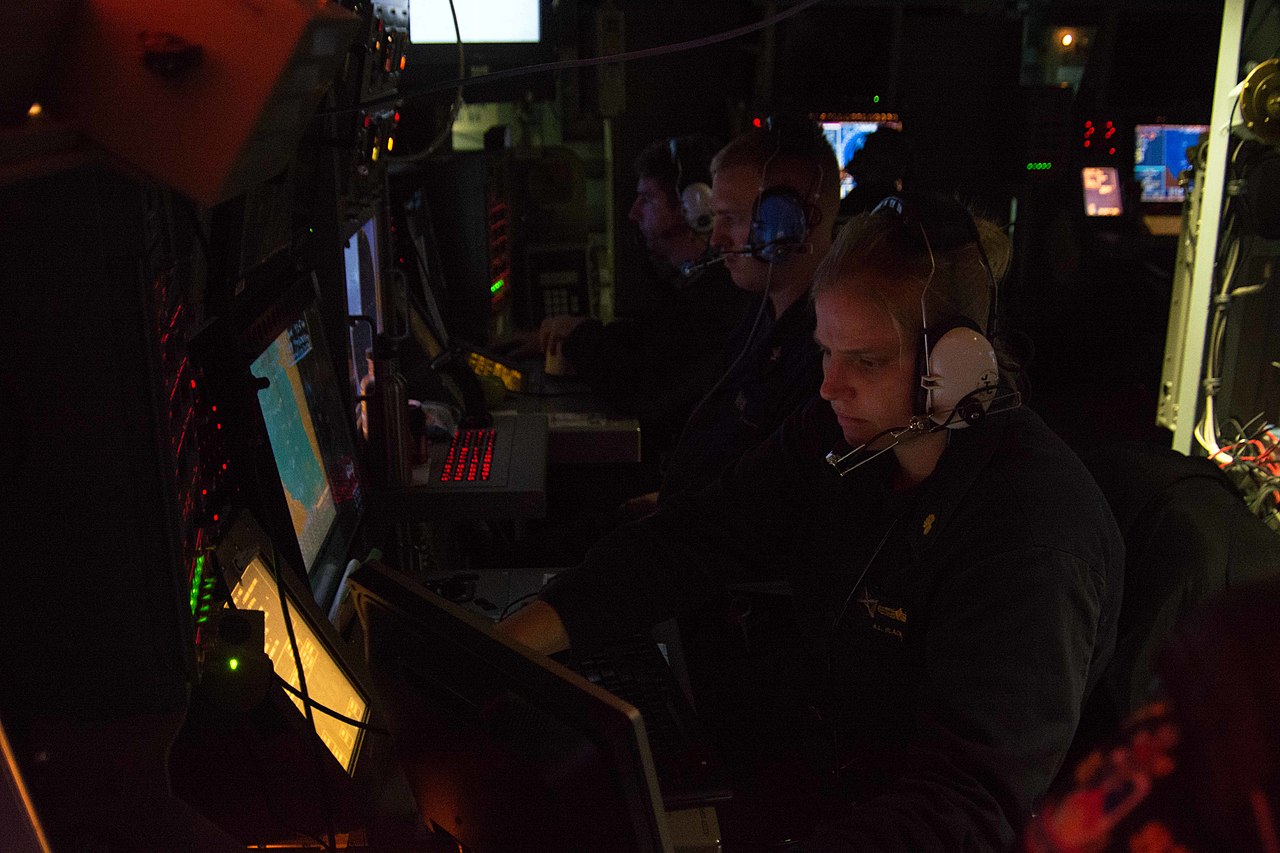
CIC onboard American destroyer Mason
Even as they were developing the system, the designers of Aegis realized that it didn't actually matter where the data came from, so long as it was precise enough. With a sufficiently rapid and precise datalink, a ship could launch missiles at a target detected by another platform and not have to turn on any radar until it was time to illuminate. Link 11 and Link 16 didn't offer the necessary precision, but a new datalink was developed as part of the system known as Cooperative Engagement Capability (CEC). CEC allowed a ship to not only launch missiles while remaining entirely passive and undetected, but also to shoot at targets hidden from it by terrain in the increasingly important inshore zone. A vessel that had radar damage or was out of ammo could still contribute to the battle, either by taking control of missiles launched by other ships at any point from launch to just before impact, or sharing its missiles with others. CEC went beyond simply sharing tracks to essentially sharing radar pictures directly. This also made it much easier to track stealthy targets, as stealth isn't 100% perfect and stealthy aircraft have "spikes" in their radar cross section, which they hide by making sure that they don't stay pointed in the same direction long enough to be turned into a track. Different platforms would see the spikes at different times, and CEC could aggregate them across the fleet.
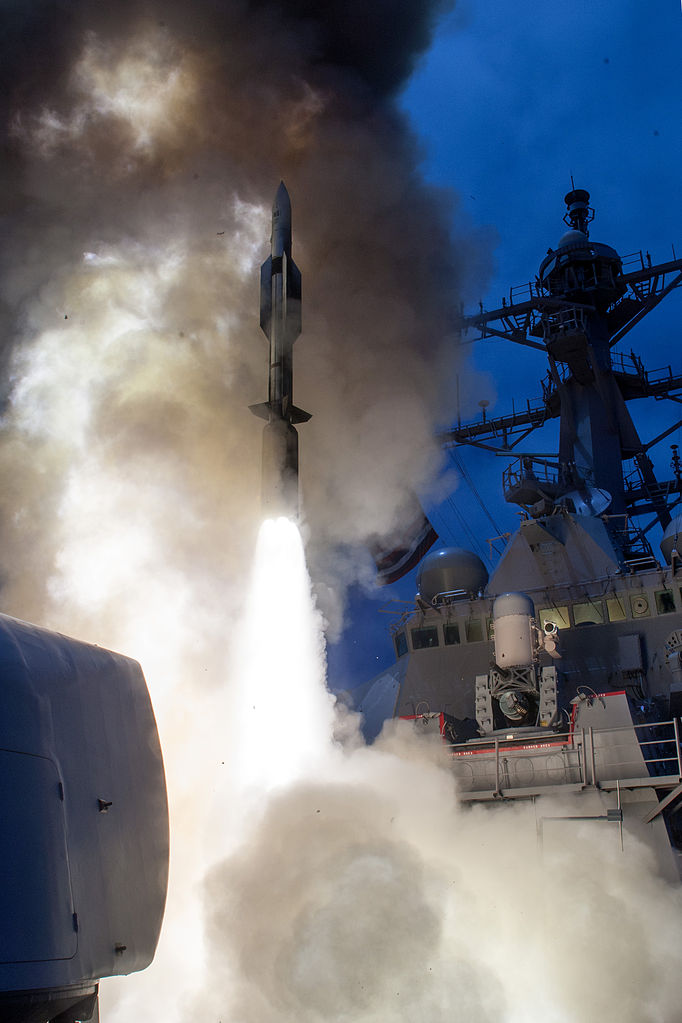
Destroyer John Paul Jones fires an ERAM
CEC wasn't just limited to the fleet's cruisers and destroyers, either. Carriers and amphibious ships were rapidly roped in, and the E-2 Hawkeye AWACS planes aboard the carriers were fitted to participate in the network as well. But this raised a serious problem. CEC wasn't precise enough to actually guide the missile all the way to impact, and the Hawkeyes in particular might well be able to see targets hidden from everyone else, but they couldn't provide terminal illumination. The Navy solved this problem quite simply, by fitting an active seeker taken from the AMRAAM missile to the existing SAMs to make the RIM-174 ERAM (Extended Range Active Missile). Any CEC unit can guide the ERAM in close to its target, at which point the active seeker will handle the rest. This also removes one of the few remaining bottlenecks on dealing with saturation attacks, the limited number of illuminators available.2
The last half-century has seen the rise of the digital computer, and with it, a vast increase in the military use of data networks. From the early days of NTDS, with vast computers on a few specialized ships, we have reached the point where not only ships and airplanes, but ground vehicles and even individual soldiers are able to participate in networks that keep track of both friends and foe, and give the forces that use them a massive advantage over those who have yet to adopt the network-centric methods that will undoubtedly define warfare in the 21st century.
1 The MIL-STD for Link 16 messages runs to over 9,000 pages. No, I am not kidding. ⇑
2 Aegis has a secondary mode to deal with this, where the illuminators all go to wide broadcast (60°) and the ship just fires all of its missiles with orders to attack whatever they can find. I wouldn't want to be nearby in this case, even if it is a bit crude. ⇑

Comments
I can't help but think that a final "In Theory" is warranted.
It has yet to be tried in earnest against an enemy with the resources to try to confuse/overwhelm/undermine it.
Yeah, the problem with network-centric warfare is that only works if the network isn't jammed which would likely not be the case against China or Russia.
That line about cursor lag sent me down the mouse-hole of early computer input devices, and apparently trackballs were developed for British radar consoles! From the diagrams I've found, it looks like NTDS used something similar.
Dealing with 16sec of input lag would probably make the user pray for the enemy missiles to hit and end their suffering, which is not optimal from a morale standpoint.
Here's a fascinating article by a NTDS program engineer. It has an interesting line about the question I asked in the last post:
Re network failure, the people who design them know of the threat, and are definitely concerned about it. Yes, it's a potential problem, but probably less of one than you might think.
@echo
I think the trackball was developed by the Canadians, not the British. I ran across that article when doing research for Part 4, but had missed that tidbit. Thanks for finding it.
On at least all of the Aegis ships and most of the SSDS ships, the CO actually still does have his own console that he can sit at...in addition to the LSDs (Large Screen Displays), which is where he focuses most of his attention.